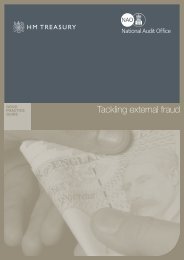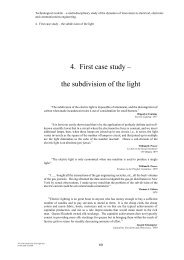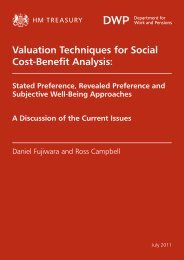Valuing Our Natural Environment Final Report ... - HM Treasury
Valuing Our Natural Environment Final Report ... - HM Treasury
Valuing Our Natural Environment Final Report ... - HM Treasury
Create successful ePaper yourself
Turn your PDF publications into a flip-book with our unique Google optimized e-Paper software.
<strong>Valuing</strong> <strong>Our</strong> <strong>Natural</strong> <strong>Environment</strong> – <strong>Final</strong> <strong>Report</strong> - Annex1<br />
determined by how people feel when they are in these states, by their preferences about<br />
them, or perhaps by some objective principles”.<br />
HYEs (healthy year equivalents) both describe the health state and provide information on<br />
its duration, in a two-stage process which first converts the multi-year scenario into a<br />
single index of utility, and then converts this into a number of “healthy year equivalents”<br />
in normal health.<br />
In principle the DALY is a straightforward variation on the QALY; however it does differ in<br />
the way in which it has been implemented, in particular by using the person trade-off (see<br />
below) and because ratings of health states have been carried out by medical experts<br />
rather than the general public. Another key difference is the use of age-weights, such that<br />
a year of life is worth different amounts at different ages (QALYs can do this, but generally<br />
don’t). The method has been used by the World Bank / WHO to derive the ‘burden of<br />
disease’ (DALYs lost due to a given disease) for many diseases and most countries.<br />
QALYs originally focused on “constant” health states, i.e. a single description of an<br />
unchanging and permanent state of health. A key contribution arising from alternatives<br />
such as HYEs (healthy year equivalents) has been the idea of directly valuing a series of<br />
different health states, and new QALY approaches have been developed to combine health<br />
states that vary over time, but these approaches have not yet been tested empirically<br />
(Towers et al., 2005).<br />
When aggregated across individuals, QALYs assume that a year of good health to one<br />
individual is worth the same as a year of good health to another. This partly ignores a host<br />
of other factors (psychology, family, social status, wealth) which may influence individuals’<br />
quality of life. But these factors may be partly reflected in QALYs, e.g. the EQ-5D 3 health<br />
state descriptive system includes “usual activities” which presumably captures some family<br />
issues and “anxiety/depression” which presumably captures some psychology issues.<br />
QALYs can be interpreted as either a representation of individual preferences and utility, or<br />
as a measure of the most important maximand in health policy. The former approach leaves<br />
open the possibility that different people value QALYs differently (with attendant problems<br />
for aggregation) while the latter simply assumes that QALYs are of equal value, on grounds<br />
of fairness. Under the latter approach, ignoring the host of other things that may affect<br />
individuals’ willingness to pay for risk reductions is not a shortcoming but an advantage: all<br />
QALYs are treated as if they had equal social value (regardless of an individual’s ability to<br />
pay for their own risk reduction). Other than through this assumption, QALYs do not<br />
attempt to consider fairness or equity. For example, they do not distinguish between an<br />
intervention giving one person 10 QALYs and one giving 100 people 0.1 QALYs each.<br />
A1.2.4.4 Process of implementation<br />
To implement QALYs requires a scale of relative values for different health states ranging<br />
from 0 (death) to 1 (perfect health). In some cases negative numbers can be used for<br />
health states which are “worse than death” (e.g. complete incapacitation with constant<br />
pain). For DALYs, weights range from 0 (perfect health) to 1 (death). To work out weights<br />
requires use of multi-attribute utility scales. For QALYs:<br />
Select a representative sample of individuals from relevant population. Ask respondents to<br />
weight different health states on a 0 to 1 scale according to:<br />
1. direct weighting of each state<br />
2. time trade-off: respondents choose the number S years of perfect health which<br />
makes them indifferent between S years in that state and T years in some other<br />
state. S/T is the weight attached to the impaired state.<br />
3. standard gamble: a choice between: (1) certainty of the impaired state for the<br />
rest of their life; and (2) a probability p of same period in perfect health, (1-p)<br />
3 EQ-5D is a standardised instrument for use as a measure of health outcome, intended for<br />
self-completion, designed by EuroQol. http://www.euroqol.org/web.<br />
eftec A42<br />
December 2006





![AIRTO [Professor Dr Brian Blunden] - HM Treasury](https://img.yumpu.com/15492848/1/184x260/airto-professor-dr-brian-blunden-hm-treasury.jpg?quality=85)










